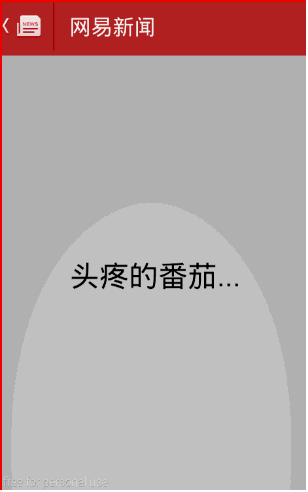效果图
思考
- 可以看出滑动的是两个layout,所以自定义的侧滑控件应该继承ViewGroup,实现onMessure()和onLayout()方法,为了简化操作,可以继承android系统已经实现好的ViewGroup的子类 —— FrameLayout,这样就不用自己去测量了。
- onLayout()方法中,初始化的时候,要将侧边菜单的布局放到屏幕左边看不到的地方。
menuView.layout(-menuWidth,0,0,menuView.getMeasuredHeight());将主页面的布局完全显示。mainView.layout(0, 0, r, b); - 为了实现偏移控制,重写一下computeScroll()方法,在初始化自定义的侧滑菜单时创建一个Scroller()对象。关于Scroller类和computeScroll()方法可参考这个链接:http://www.cnblogs.com/wanqieddy/archive/2012/05/05/2484534.html
- 接下来就是在onTouchEvent()方法中进行判断了。
- 手指按下时,记录按下的x坐标。
- 手指移动时,计算出在x方向滑动的距离deltaX,获取当前view的左边在屏幕上的x的距离getScrollX(),减去deltaX,就得到应该移动的距离了。
- 手指抬起时,判断一下,如果偏移的距离大于菜单布局的宽的一半,就关闭菜单,否则,打开菜单。
步骤
1. 主页面的布局
<RelativeLayout xmlns:android="http://schemas.android.com/apk/res/android"
xmlns:tools="http://schemas.android.com/tools"
android:layout_width="match_parent"
android:layout_height="match_parent">
<com.example.slidingmenu.view.SlidingMenu
android:id="@+id/slidingMenu"
android:layout_width="match_parent"
android:layout_height="match_parent">
<include layout="@layout/layout_menu" />
<include layout="@layout/layout_main" />
</com.example.slidingmenu.view.SlidingMenu>
</RelativeLayout>
2. 主内容的布局
<?xml version="1.0" encoding="utf-8"?>
<LinearLayout xmlns:android="http://schemas.android.com/apk/res/android"
android:layout_width="match_parent"
android:layout_height="match_parent"
android:background="#55666666"
android:orientation="vertical">
<LinearLayout
android:layout_width="match_parent"
android:layout_height="60dp"
android:background="@mipmap/top_bar_bg"
android:gravity="center_vertical">
<ImageView
android:id="@+id/btn_back"
android:layout_width="wrap_content"
android:layout_height="wrap_content"
android:background="@mipmap/main_back" />
<View
android:layout_width="1dp"
android:layout_height="match_parent"
android:layout_marginBottom="5dp"
android:layout_marginTop="5dp"
android:background="@mipmap/top_bar_divider" />
<TextView
android:layout_width="wrap_content"
android:layout_height="wrap_content"
android:layout_marginLeft="15dp"
android:text="网易新闻"
android:textColor="#ffffff"
android:textSize="22sp" />
</LinearLayout>
<TextView
android:layout_width="match_parent"
android:layout_height="match_parent"
android:gravity="center"
android:text="头疼的番茄..."
android:textColor="#000000"
android:textSize="30sp" />
</LinearLayout>3. 侧边菜单栏的布局
<?xml version="1.0" encoding="utf-8"?>
<ScrollView xmlns:android="http://schemas.android.com/apk/res/android"
android:layout_width="240dp"
android:layout_height="match_parent"
android:background="@mipmap/menu_bg"
android:orientation="vertical">
<LinearLayout
android:layout_width="match_parent"
android:layout_height="wrap_content"
android:orientation="vertical"
android:paddingBottom="300dp">
<TextView
style="@style/MenuTabText"
android:background="#33aa9900"
android:drawableLeft="@mipmap/tab_news"
android:text="新闻" />
<TextView
style="@style/MenuTabText"
android:drawableLeft="@mipmap/tab_read"
android:text="订阅" />
<TextView
style="@style/MenuTabText"
android:drawableLeft="@mipmap/tab_ties"
android:text="跟帖" />
<TextView
style="@style/MenuTabText"
android:drawableLeft="@mipmap/tab_pics"
android:text="图片" />
<TextView
style="@style/MenuTabText"
android:drawableLeft="@mipmap/tab_ugc"
android:text="话题" />
<TextView
style="@style/MenuTabText"
android:drawableLeft="@mipmap/tab_vote"
android:text="投票" />
<TextView
style="@style/MenuTabText"
android:drawableLeft="@mipmap/tab_focus"
android:text="聚合阅读" />
</LinearLayout>
</ScrollView>4. 自定义菜单的代码
public class SlidingMenu extends FrameLayout{
private View menuView,mainView;
private int menuWidth = 0;
private Scroller scroller;
public SlidingMenu(Context context, AttributeSet attrs) {
super(context, attrs);
init();
}
public SlidingMenu(Context context) {
super(context);
init();
}
private void init(){
scroller = new Scroller(getContext());
}
/**
* 当1级的子view全部加载完调用,可以用初始化子view的引用
* 注意,这里无法获取子view的宽高
*/
@Override
protected void onFinishInflate() {
super.onFinishInflate();
menuView = getChildAt(0);
mainView = getChildAt(1);
menuWidth = menuView.getLayoutParams().width;
}
/**
* widthMeasureSpec和heightMeasureSpec是系统测量SlideMenu时传入的参数,
* 这2个参数测量出的宽高能让SlideMenu充满窗体,其实是正好等于屏幕宽高
*/
// @Override
// protected void onMeasure(int widthMeasureSpec, int heightMeasureSpec) {
// super.onMeasure(widthMeasureSpec, heightMeasureSpec);
//
// int measureSpec = MeasureSpec.makeMeasureSpec(menuWidth, MeasureSpec.EXACTLY);
//
// //测量所有子view的宽高
// //通过getLayoutParams方法可以获取到布局文件中指定宽高
// menuView.measure(measureSpec, heightMeasureSpec);
// //直接使用SlideMenu的测量参数,因为它的宽高都是充满父窗体
// mainView.measure(widthMeasureSpec, heightMeasureSpec);
//
// }
@Override
public boolean onInterceptTouchEvent(MotionEvent ev) {
switch (ev.getAction()) {
case MotionEvent.ACTION_DOWN:
downX = (int) ev.getX();
break;
case MotionEvent.ACTION_MOVE:
int deltaX = (int) ( ev.getX()- downX);
if(Math.abs(deltaX)>8){
return true;
}
break;
}
return super.onInterceptTouchEvent(ev);
// return super.onInterceptTouchEvent(ev);
}
/**
* l: 当前子view的左边在父view的坐标系中的x坐标
* t: 当前子view的顶边在父view的坐标系中的y坐标
*/
@Override
protected void onLayout(boolean changed, int l, int t, int r, int b) {
// Log.e("MAIN", "L: "+l+" t: "+t +" r: "+r + " b: "+b);
menuView.layout(-menuWidth, 0, 0, menuView.getMeasuredHeight());
mainView.layout(0, 0, r, b);
}
private int downX;
@Override
public boolean onTouchEvent(MotionEvent event) {
switch (event.getAction()) {
case MotionEvent.ACTION_DOWN:
downX = (int) event.getX();
break;
case MotionEvent.ACTION_MOVE:
int moveX = (int) event.getX();
int deltaX = (int) ( moveX- downX);
int newScrollX = getScrollX() - deltaX;
if(newScrollX<-menuWidth)newScrollX = -menuWidth;
if(newScrollX>0)newScrollX = 0;
Log.e("Main", "scrollX: " + getScrollX());
scrollTo(newScrollX, 0);
downX = moveX;
break;
case MotionEvent.ACTION_UP:
//1.使用自定义动画
// ScrollAnimation scrollAnimation;
// if(getScrollX()>-menuWidth/2){
// //关闭菜单
scrollTo(0, 0);
// scrollAnimation = new ScrollAnimation(this, 0);
// }else {
// //打开菜单
scrollTo(-menuWidth, 0);
// scrollAnimation = new ScrollAnimation(this, -menuWidth);
// }
// startAnimation(scrollAnimation);
//2.使用Scroller
if(getScrollX()>-menuWidth/2){
// //关闭菜单
closeMenu();
}else {
//打开菜单
openMenu();
}
break;
}
return true;
}
private void closeMenu(){
scroller.startScroll(getScrollX(), 0, 0-getScrollX(), 0, 400);
invalidate();
}
private void openMenu(){
scroller.startScroll(getScrollX(), 0, -menuWidth-getScrollX(), 0, 400);
invalidate();
}
/**
* Scroller不主动去调用这个方法
* 而invalidate()可以掉这个方法
* invalidate->draw->computeScroll
*/
@Override
public void computeScroll() {
super.computeScroll();
if(scroller.computeScrollOffset()){//返回true,表示动画没结束
scrollTo(scroller.getCurrX(), 0);
invalidate();
}
}
/**
* 切换菜单的开和关
*/
public void switchMenu() {
if(getScrollX()==0){
//需要打开
openMenu();
}else {
//需要关闭
closeMenu();
}
}
}
5. 主函数的代码
public class MainActivity extends Activity {
private ImageView btn_back;
private SlidingMenu slideMenu;
@Override
protected void onCreate(Bundle savedInstanceState) {
super.onCreate(savedInstanceState);
requestWindowFeature(Window.FEATURE_NO_TITLE);
setContentView(R.layout.activity_main);
btn_back = (ImageView) findViewById(R.id.btn_back);
slideMenu = (SlidingMenu) findViewById(R.id.slidingMenu);
btn_back.setOnClickListener(new View.OnClickListener() {
@Override
public void onClick(View v) {
slideMenu.switchMenu();
}
});
}
}6. 补充 :第一种滑动方式 自定义动画的代码
public class ScrollAnimation extends Animation{
private View view;
private int targetScrollX;
private int startScrollX;
private int totalValue;
public ScrollAnimation(View view, int targetScrollX) {
super();
this.view = view;
this.targetScrollX = targetScrollX;
startScrollX = view.getScrollX();
totalValue = this.targetScrollX - startScrollX;
int time = Math.abs(totalValue);
setDuration(time);
}
/**
* 在指定的时间内一直执行该方法,直到动画结束
* interpolatedTime:0-1 标识动画执行的进度或者百分比
* time : 0 - 0.5 - 0.7 - 1
* value: 10 - 60 - 80 - 110
* 当前的值 = 起始值 + 总的差值*interpolatedTime
*/
@Override
protected void applyTransformation(float interpolatedTime,
Transformation t) {
super.applyTransformation(interpolatedTime, t);
int currentScrollX = (int) (startScrollX + totalValue*interpolatedTime);
view.scrollTo(currentScrollX, 0);
}
}






















 1030
1030

 被折叠的 条评论
为什么被折叠?
被折叠的 条评论
为什么被折叠?








